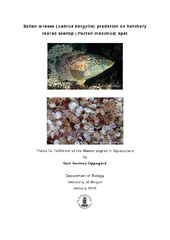Ballan wrasse (Labrus bergylta) predation on hatchery reared scallop (Pecten maximus) spat
Master thesis
Permanent lenke
https://hdl.handle.net/1956/1261Utgivelsesdato
2005Metadata
Vis full innførselSamlinger
Sammendrag
Sea ranching of the great scallop (Pecten maximus) may have a high potential for future aquaculture in Norway. The edible crab (Cancer pagurus) and starfish (Asterias rubens) have been identified as the major predators, causing great losses of released scallops. In order to reduce predation by these species, a functional fence was designed to protect scallop sea ranches. The fence has greatly improved the survival rate. However, fish are not obstructed by a fence and ballan wrasse (Labrus bergylta) have been observed nabbing and eating on spat at a ranching site. The present study demonstrates that ballan wrasse (sized 22 to 40.5 cm) prey on cultivated scallop spat (15-34 mm) and show that the predation is size specific. It is shown that ballan wrasse prefer scallops smaller than 25 mm in shell height, and that larger scallops only to a small degree is preyed. It is suggested that the spat are not protected from predation by ballan wrasse when the scallops recess into the sediment. These findings are important for optimising fenced sea ranching in Norway. An intermediate culture has traditionally been necessary for protection from predators during outgrow of spat to a size of about 50 mm. However, this phase is expensive and labour intensive. Results from the present study suggest that scallop spat can be seeded in a fenced area on the seafloor at a size of 25-30 mm in shell height, without suffering severe losses due to predation by ballan wrasse.
Utgiver
The University of BergenOpphavsrett
The authorCopyright the author. All rights reserved
